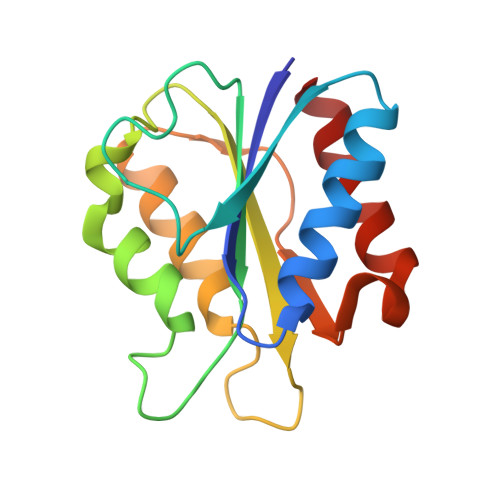Pseudosymmetry, high copy number and twinning complicate the structure determination of Desulfovibrio desulfuricans (ATCC 29577) flavodoxin.
Guelker, M., Stagg, L., Wittung-Stafshede, P., Shamoo, Y.(2009) Acta Crystallogr D Biol Crystallogr 65: 523-534
- PubMed: 19465766
- DOI: https://doi.org/10.1107/S0907444909010075
- Primary Citation of Related Structures:
3F6R, 3F6S - PubMed Abstract:
The crystal structure of oxidized flavodoxin from Desulfovibrio desulfuricans (ATCC 29577) was determined by molecular replacement in two crystal forms, P3(1)21 and P4(3), at 2.5 and 2.0 A resolution, respectively. Structure determination in space group P3(1)21 was challenging owing to the presence of pseudo-translational symmetry and a high copy number in the asymmetric unit (8). Initial phasing attempts in space group P3(1)21 by molecular replacement using a poor search model (46% identity) and multi-wavelength anomalous dispersion were unsuccessful. It was necessary to solve the structure in a second crystal form, space group P4(3), which was characterized by almost perfect twinning, in order to obtain a suitable search model for molecular replacement. This search model with complementary approaches to molecular replacement utilizing the pseudo-translational symmetry operators determined by analysis of the native Patterson map facilitated the selection and manual placement of molecules to generate an initial solution in the P3(1)21 crystal form. During the early stages of refinement, application of the appropriate twin law, (-h, -k, l), was required to converge to reasonable R-factor values despite the fact that in the final analysis the data were untwinned and the twin law could subsequently be removed. The approaches used in structure determination and refinement may be applicable to other crystal structures characterized by these complicating factors. The refined model shows flexibility of the flavin mononucleotide coordinating loops indicated by the isolation of two loop conformations and provides a starting point for the elucidation of the mechanism used for protein-partner recognition.
Organizational Affiliation:
Department of Biochemistry and Cell Biology, Rice University, Houston, TX 77005, USA.


























